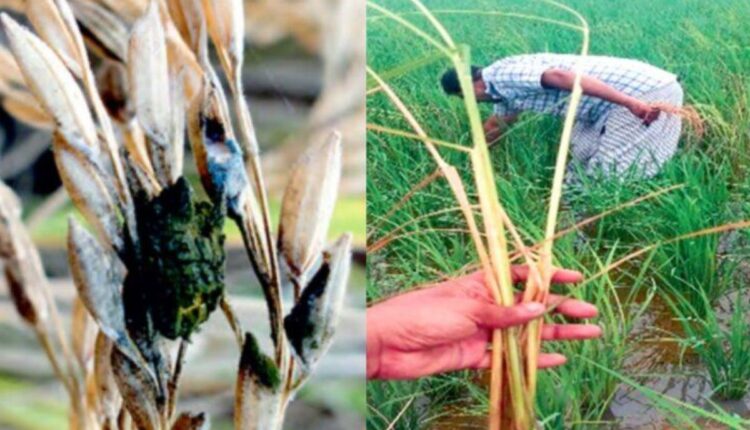How to manage Diseases in Basmati Paddy? What are the remedies?
Basmati rice is known for its exquisite aroma and taste.
Outbreak of Pests and Diseases in Basmati Paddy | Nowadays, farmers use chemical-rich pesticides in almost all the crops to protect the crop from pests, but sometimes the quality of the crop is affected due to their high quantity.
Due to the high incidence of pests and diseases in paddy crops, especially basmati paddy, farmers use pesticides in it. But some are not aware of its exact quantity. In such a situation, if it is used excessively till two months before the crop ripens. Then the residues of pesticides remain on the paddy, which not only affects its quality but also makes it dangerous for health. There is a good demand for Basmati rice in foreign countries also. It helps farmers to earn good profit through export, but if they do not control pesticides, they can snatch the opportunity of export.
In fact, America, Iran, and the European Union have made it clear that if pesticides are used in Basmati paddy beyond the prescribed limit, then farmers will not be able to export it. In such a situation, it is necessary that either farmers limit the use of pesticides. Also, they can start using organic pesticides instead of chemical ones. Come, and let us know about some pests and diseases affecting Basmati paddy.
Bakanae Disease – It is also known as Jhanda disease. It is caused by a fungus called Fusarium Moniliforme from the soil. Its effect is visible about a month after transplanting the plant in the nursery or field. Infected plants grow taller than normal plants. Plants become thin. Leaves turn yellow. Its roots turn black and spots appear on them. This disease affects the Basmati rice variety Pusa Sugandha-4 (1121) and Pusa 1509 more. This disease is more in sandy soil.
Bacterial Leaf Blight Disease – It is spread by a bacterium named Xanthomonas oryzae. This disease is caused by seeds. This disease affects plants in two stages. The first is shoot blight and the second is leaf blight. Sprout scorching is considered more dangerous. The symptoms of this disease first appear on the leaves 20-25 days after transplanting. The small leaves of the plant turn pale yellow and gradually the whole plant dries up.
This disease does not appear simultaneously in the entire field, but starts from a few plants and spreads gradually. First yellow or light yellow stripes start forming on the leaves and then they dry up. The reasons for the development of this disease include the rainy season, light winds and temperatures of 28-30 degree Celsius, excessive use of nitrogen in the crop, etc.
Cover Scorching Disease – This disease is also caused by soil. Large circular spots appear on the leaves just above the surface of the water. These spots gradually develop into large striped straw-colored spots at the base of the leaves and surround the stem from all sides. The area between the spots is slightly gray or white while fungus produces black-colored grains on the leaves. First, the lower leaves and then the entire leaves are affected by the disease and then the entire plant gets scorched. The disease spreads rapidly due to temperatures of 28-30°C and dense planting, the application of more nitrogen in the crop.
Blight Disease – This disease is caused by seed and wind, which causes a lot of damage to the paddy crop. At the beginning of this disease, small spots are formed on the leaves and their lower parts, which gradually enlarge and become eye- or boat-shaped. When the ear of the paddy starts to form, then in this stage a black ring is formed on the nodes under the ear, and the ear is broken. During crop cultivation, when the night temperature is 20-22 degrees and the humidity is more than 95 percent, the chances of an outbreak of this disease are high.
Brown Leaf Spot Disease – This is a seed and soil-borne disease. In this, small round brown spots are formed on the leaves. As the disease progresses, spots appear on most of the leaves from the bottom to the top of the plants. This disease mainly occurs in water-deficient areas. Along with this, its outbreak is more visible in the areas where the fertility of paddy is low. The causes of this disease include prolonged wetness of the leaves and the pH of the soil. Excess balance, late transplanting and plants not getting complete nutrition, etc.
If you want your Basmati paddy crop to be safe from these diseases and pests, then you have to take care of some things:
- Instead of any seed, use only certified seed for sowing.
- After harvesting of paddy, remove the remaining stalks or strangle them with the help of a decomposer.
- Treat seeds organically. For this, treat one kg of seed with 5 grams of Trichoderma.
- Do not plant too densely, it increases the risk of diseases.
- Before transplanting, immerse the roots of the plants for 30 minutes by dissolving Pseudomonas fluorescens at 10 grams per liter of water.
- Uproot the affected plants along with the roots and plant them in another vacant field.
- Use fungicides if necessary, but only according to the advice of agricultural experts.
Also Read: Black rice cultivation got good price to this farmer
Contact us – If farmers want to share any valuable information or experiences related to farming, they can connect with us via phone or WhatsApp at 9599273766 or you can write to us at “[email protected]”. Through Kisan of India, we will convey your message to the people, because we believe that if the farmers are advanced then the country is happy.
You can connect with Kisan of India on Facebook, Twitter, and WhatsApp and Subscribe to our YouTube channel.



